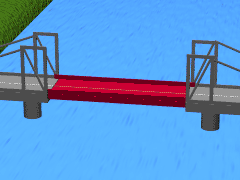Vertical-lift bridge
 An animation showing how a vertical-lift bridge operates with vehicular and shipping traffic | |
| Ancestor | Truss bridge |
|---|---|
| Related | Bascule bridge, swing bridge, folding bridge, retractable bridge |
| Descendant | Submersible bridge, table bridge |
| Carries | Automobile, pedestrians, truck, light rail, heavy rail |
| Span range | Short |
| Material | Steel |
| Movable | Yes |
| Design effort | medium |
| Falsework required | Depends upon degree of prefabrication |
A vertical-lift bridge or just lift bridge is a type of movable bridge in which a span rises vertically while remaining parallel with the deck.
The vertical lift offers several benefits over other movable bridges such as the bascule and swing-span bridges. Generally speaking they cost less to build for longer moveable spans.[1] The counterweights in a vertical lift are only required to be equal to the weight of the deck, whereas bascule bridge counterweights must weigh several times as much as the span being lifted. As a result, heavier materials can be used in the deck, and so this type of bridge is especially suited for heavy railroad use. The biggest disadvantage to the vertical-lift bridge (in comparison with many other designs) is the height restriction for vessels passing under it, due to the deck remaining suspended above the passageway.
Although most vertical-lift bridges use towers, each equipped with counterweights, some use hydraulic jacks located below the deck. An example is the 52-foot (15.85 m) span bridge at St Paul Avenue in Milwaukee[2] (see also table bridges). Another design used balance beams to lift the deck, with pivoting bascules located on the top of the lift towers.[3] An example of this kind was built at La Salle in Illinois, United States.
Examples[]
See List of vertical-lift bridges.
Gallery of images[]

One of the vertical-lift bridges over the Gouwe River. It was built in 1930.

ASB Bridge in Kansas City, Missouri.

The Arthur Kill Vertical Lift Bridge has the longest lift span of any vertical-lift bridge in the world.

The Hawthorne Bridge (in Portland, Oregon, U.S.), built in 1910, the oldest vertical-lift bridge in the United States[4] and probably the world.

A lift bridge over the Erie Canal at Lockport...

...elevates at both ends...

...and nears its upward position. Pedestrians may cross when it is up using stairways.

Small lift bridge in Nowa Sól, Poland
See also[]
- Moveable bridges for a list of other movable bridge types
- Submersible bridge for a similar disappearing bridge
- Table bridge for a vertical-lift bridge without visible lifting means
References[]
Bibliography[]
- Leonardo Fernandez Troyano (2003). Bridge Engineering: A Global Perspective. Thomas Telford Publishing. ISBN 978-0-7277-3215-6.
External links[]
 Media related to Vertical-lift bridges at Wikimedia Commons
Media related to Vertical-lift bridges at Wikimedia Commons
- Vertical lift bridges
- Bridges by structural type








